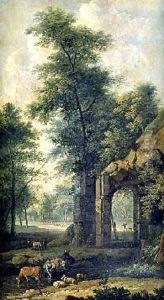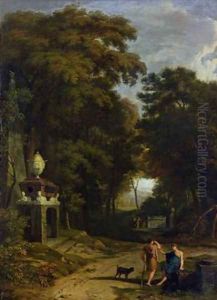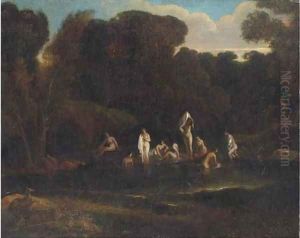Albert Meyering Paintings
Albert Meyering, also known as Meijeringh, was a Dutch Golden Age painter and etcher born in 1645 in Amsterdam, Netherlands. His artistic journey began under the tutelage of the renowned landscape painter Meindert Hobbema, a pupil of Jacob van Ruisdael. This mentorship deeply influenced Meyering's approach to landscape painting, embedding in his work the characteristic depth, realism, and attention to detail that were hallmarks of Hobbema's style. Despite the influence, Meyering carved out his own unique path in the art world, distinguishing himself through his versatile depictions of landscapes, particularly Italianate and pastoral scenes.
Meyering's oeuvre is notable for its expansive landscapes imbued with a serene, idyllic quality that reflects a romanticized view of nature. His work often features classical ruins, pastoral scenes with cattle and shepherds, and occasionally, more rugged and dramatic natural settings. These elements were not just mere reproductions of nature but were imbued with a sense of harmony and order, reflecting the artist's interpretation of the landscape as an idealized realm. This was in keeping with the tastes of the time, where such romanticized depictions were highly sought after by collectors and art patrons.
Throughout his career, Meyering remained active in Amsterdam, where he contributed to the city's vibrant art scene. However, his work also shows evidence of travels or at least a strong influence from other European art traditions, particularly Italian. The Italianate landscapes, a genre that was popular among Dutch artists of the 17th century, are especially prominent in his portfolio. These works feature the warm, sunlit scenes of Italy, complete with ancient ruins and figures in classical attire, showcasing Meyering's ability to blend his Northern European perspective with the allure of the Mediterranean.
Despite his talents and contributions to the Dutch Golden Age of painting, Meyering did not achieve the same level of fame as some of his contemporaries. Nevertheless, his works were appreciated in his time and continue to be recognized for their beauty and craftsmanship. Albert Meyering's legacy is preserved in various collections and museums, where his landscapes offer viewers a glimpse into the idyllic and romanticized visions of nature that captivated the 17th-century imagination.
Albert Meyering died in 1714 in Amsterdam, leaving behind a body of work that, while not as widely known as that of some of his peers, remains an important part of the Dutch artistic heritage. His paintings continue to be studied and admired for their contribution to the development of landscape painting in the Netherlands, marking him as a significant figure in the history of Dutch art.



